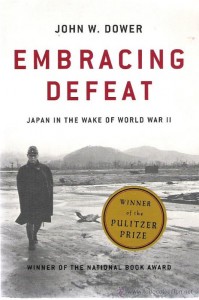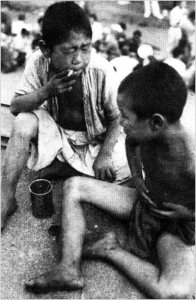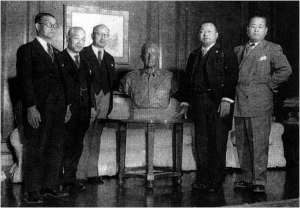Embracing Defeat
Japan in the Wake of World War II
Book informations
Paperback:676 pages
Publisher:W. W. Norton & Company; First edition. edition (June 17, 2000)
Language:English
ISBN10:0393320278
ISBN13:9780393320275
Product Dimensions:3, 2 x 15, 2 x 22, 9 cm
Shipping Weight:1. 9 pounds
Award :
the U. S. National Book Award for Nonfiction,
the Pulitzer Prize for General Nonfiction,
the Bancroft Prize, the Los Angeles Times Book Prize, the Mark Lynton History Prize,
the John K. Fairbank Prize of the American Historical Association.
Motivation
Japan is a very beautiful country and also is a closer economic partner for China. But for the new generation of China, their feelings toward Japan remain complex. On the one hand, they could not forget that Japan waged war on China in 1937, and the fact that, after Cold War, Japanese Right Wing tries to deny its history of invasion, tries hard to prettify the crime of invasion. On the other hand, the high growth of Japan’s economy during the period of 1955-1973 is undoubtedly a miracle in the history of the postwar world economy. But many young people still want to get to know how painful are there during the period of recover and the specific reason behind. I like the Japanese culture and always watching Japanese TV programs and dramas, those can really help me to know the modern Japan. Therefore, through these book, maybe I could understand and calm to know what had happened to our neighbors in the past 60 years. That is the reason, why I choose these book for our media and literature forum.
Author
John W. Dower, author and historian, emeritus professor of Japanese history. Dower was born 21 June 1938 in Providence, Rhode Islandearned. He earned a bachelor’s degree in American Studies from Amherst College in 1959, and a Ph.D. in History and Far Eastern Languages from Harvard University in 1972
Recnetly, he retired from the History faculty in 2010 but remains active in MIT’s online “Visualizing Cultures” project, a pioneering website he cofounded in 2002 that breaks new ground in the scholarly use of visual materials to reexamine the experience of Japan and China in the modern world. As of 2012, eleven of the lengthy presentations on this multiunit site were authored by him.
Books by Professor Dower include The Elements of Japanese Design, (1971); Origins of the Modern Japanese State: Selected Writings of E. H. Norman (1975); Empire and Aftermath: Yoshida Shigeru and the Japanese Experience, 1876-1945(1979); A Century of Japanese Photography (edited, 1980); The Hiroshima Murals: The Art of Iri Maruki and Toshi Maruki(coedited, 1985); War Without Mercy: Race and Power in the Pacific War (1986); Japan in War and Peace: Selected Essays (1994); Embracing Defeat: Japan in the Wake of World War II(1999); Cultures of War: Pearl Harbor/Hiroshima/911/Iraq(2010); and Ways of Forgetting, Ways of Remembering: Japan in the Modern World (2012). War Without Mercy won several prizes in the United States and Japan, including the National Book Critics Circle Award. Awards for Embracing Defeat include the Pulitzer Prize (for general nonfiction), National Book Award (for nonfiction), Bancroft Prize (for U. S. hisotry), Fairbanks Prize (for history of Asia), Los Angeles Times Book Prize (in history), and two prestigious Japanese prizes for the documentary version of its work. Professor Dower also was executive producer of a documentary titled Hellfire: A Journey from Hiroshima that was a finalist for an academy award in 1988.
Perhaps, it is also important to understand the background, that is, his wife Yasuko is a Japanese lady, that maybe would help professor John Dower understood Japanese historia not only the academic side but also the emotional side.
Structure and Content
“Embracing defeat” panoramically describes the great changes in Japanese society in the six years after defeat. Understanding these history of this period, can really help readers to have a insight to the origin of the contemporary Japanese society structure and the contemporary Japanese mentality.
It consists of following five big parts:
Part I. Victor and Vanquished
Part II. Transcending despair
Part III. Revolutions
Part IV. Democracies
Part V. Guilts
Each part is divided into several chapters, and totally are 17 chapters, each chapter then has several sections, each section are closely subheadings simultaneously. So from its various subheadings can clearly understand the main content.
In the first three parts,mainly interpret the situation and feeling of Japanese civilians after defeat, and also they are the parts interested me mostly. So I collected some points from them which are impressed me deeply.
1) When they heard the news of the surrender, the ordinary Japanese reflect more of a remorse, bereavement, suffering the wrath of deception, and covering the sudden emptiness and the loss of objectives, rather than the nostalgia of war. All told, probably at least 2. 7 million servicemen and civilians died as a result of the war, roughly 3 to 4 percent of the country’s 1941 population of around 74 million. Millions more were injured, sick, or seriously malnourished.
In Tokyo, the largest metropolis, 65 percent of all residences were destroyed. In Osaka and Nagoya, the country’s second and third largest cities, the figures were 57 and 89 percent.
2) For the Japanese people, what the defeat brought to them, one is economic hardship, the other are tired of war and contempt for the militarists which brought its huge disaster. Vanquished want to both forget the past and to go beyond the past. Most people are politically apathetic, war disgust economic animal. They are neither concerned noisy parliamentary politics, but also deliberately avoided their ancestors in the crimes committed during World War II.
3) The group cohesion and discipline of the military hierarchy had not been built, as its propagandists intoned, on some idealized notion of “loyalty” or “harmony, ” but on a structure of authoritarian coercion that transferred oppression downward. Superior officers commonly commanded fear rather than respect even in the best of times, and defeat unleashed deep, hitherto repressed resentments.
Soldiers who returned from the war, generally received contempt rather than sympathy for help. Disabled veterans were doubly stigmatized, having lost the war as well as their physical or mental wholeness. Similarly, once sentimental effusions had been dispensed with, the war’s youngest victims were treated abysmally. War orphans and homeless children almost by definition became “improper” children. Forced to scramble for daily survival on the streets, they became treated as incorrigible delinquents.
War orphans and homeless children almost by definition became “improper” children. Forced to scramble for daily survival on the streets, they became treated as incorrigible delinquents.
An anonymous letter published in the Asahi on June 9, 1946 captured the bleakness of such “homecomings”:
I returned to Japan from the southern regions on May 20. My house was burned, my wife and children missing. What little money I had quickly was consumed by the high prices, and I was a pitiful figure. Not a single person gave me a kind word. Rather, they cast hostile glances my way. Tormented and without work, I became possessed by a devil.
4) At that moment, the three most popular activities among small boys and girls were yamiichigokko, panpan asobi, and demo asobi-that is, holding a mock black market, playing prostitute and customer, and recreating left-wing political demonstrations.
As youngsters grew older, play shaded into practice. School-boys as well as orphans and runaways quickly learned how to earn pocket money as pimps by leading GIs to women. “You like to meet my sister?” became, for some, the next level of English instead of “give me chocolate. ”
5) Douglas Mac Arthur’s singular command over the occupation-indeed, his very title of Supreme Commander-epitomized the American monopoly on policy and power. The imperious MacArthur until 1948 reigned as a minor potentate in his Far Eastern domain. He had not only the normal executive authorities such as American President has in this country, but he had legislative authority. He could by fiat issue directives.
Hundreds of letters and postcards, which were addressed directly to General MacArthur, arrived daily throughout the occupation. Writers praised the general’s “exalted and godlike benevolence” and called him a “living savior. ”
MacArthur was also showered with gift, He received dolls, lamps, ceramics, lacquer work, bamboo products, feudal manuscripts, books, miniaturized bonsai trees, bonkei tray landscapes, animal skins, armor, and swords, as well a s paintings and sculptures that sometimes included renderings of himself.
Summarize
The author’s perspective scrutinized almost every corner of Japanese society in postwar. Although it is a personal point of view, but its plain objectively interpretation telling the story to readers convincingly.
There are not too many value evaluation and impetuous, just using letters from newspapers and all kinds of life pictures at that time, those to let readers closely know more about the facts. With the stories of countless little poor person and using of lively narratives, the author spread out the Japanese life picture scroll in postwar, and the processes of disillusionment and reconstruction of the Japanese people’s spirit.
Through reading these book, what impressed me deeply are the Japanese civilians also suffered a very hard time after the war.But they struggled with the roughly situation, and try to reestablish their own new life, works and religious, those were all in ruins in past years. At length, their successfully overcame all the hardships, that maybe are the things what we can learn.

Pingback: billy
Pingback: joshua
Pingback: norman
Pingback: ronald
Pingback: nicholas
Pingback: Fred
Pingback: Travis
Pingback: Danny
Pingback: Cameron
Pingback: Antonio
Pingback: billy
Pingback: max
Pingback: Otis
Pingback: Vernon
Pingback: Kenneth
Pingback: corey
Pingback: ernest
Pingback: Jacob
Pingback: ben
Pingback: nelson
Pingback: Adam
Pingback: Wayne
Pingback: Patrick
Pingback: Nelson
Pingback: Shawn
Pingback: tyler
Pingback: sean
Pingback: Zachary
Pingback: Lance
Pingback: Lloyd
Pingback: Leo
Pingback: Harry
Pingback: keith
Pingback: Carlos
Pingback: Kenny
Pingback: harold
Pingback: everett
Pingback: frank